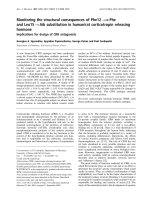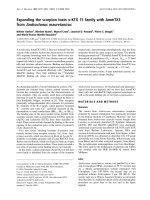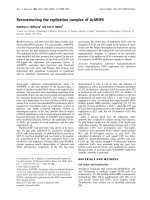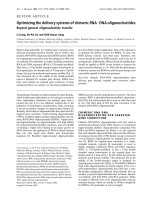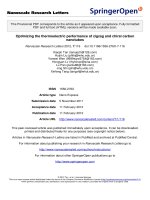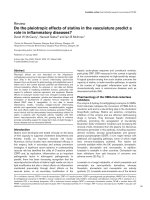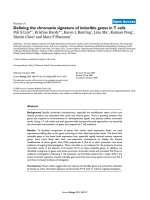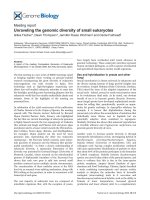Báo cáo Y học: Optimizing the delivery systems of chimeric RNA . DNA oligonucleotides Beyond general oligonucleotide transfer ppt
Bạn đang xem bản rút gọn của tài liệu. Xem và tải ngay bản đầy đủ của tài liệu tại đây (173.95 KB, 6 trang )
REVIEW ARTICLE
Optimizing the delivery systems of chimeric RNA
.
DNA oligonucleotides
Beyond general oligonucleotide transfer
Li Liang, De-Pei Liu and Chih-Chuan Liang
National Laboratory of Medical Molecular Biology, Institute of Basic Medical Sciences, Chinese Academy of Medical Sciences &
Peking Union Medical College, Beijing, People’s Republic of China
Special oligonucleotides for targeted gene correction have
attracted increasing attention recently, one of which is the
chimeric RNAÆDNA oligonucleotide (RDO) system. RDOs
for targeted gene correction were first designed in 1996, and
are typically 68 nucleotides in length including continuous
RNA and DNA sequences (RNA is 2¢-O-methyl-modified).
They have a 25 bp double stranded region homologous to
the targeted gene, two hairpin ends of T loop and a 5 bp GC
clamp, that give the molecule much greater stability [Fig. 1].
One mismatch site in the middle of the double-stranded
region is designed for targeted gene therapy. RDOs have
been used recently for targeted gene correction of point
mutations both in vitro and in vivo, but many problems must
be solved before clinical application. One of the solutions is
to optimize the delivery vectors for RDOs. To date, few
RDO delivery systems have been used. Therefore, new
vectors should be tried for RDO transfer, such as the use of
nanoparticles. Additionally, different kinds of modifications
should be applied to RDO carrier systems to increase the
total correction efficiency in vivo. Only with the development
of delivery systems can RDOs be used for gene therapy, and
successfully applied to functional genomics.
Keywords: chimeric RNAÆDNA oligonucleotides; gene
delivery; gene therapy; targeted gene correction; nano-
particles.
Targeted gene therapies are ideal strategies for gene therapy,
which include gene replacement in situ and gene correction.
Gene replacement substitutes the mutated gene with a
normal one, but it is a low efficiency method due to the
limitation of homologous recombination. Gene correction
is the most putative strategy of targeted gene therapy [1].
Recently, three kinds of oligonucleotides have been used for
targeted gene correction: triplex-forming oligonucleotides
(TFOs), modified single-stranded oligonucleotides and chi-
meric RNAÆDNA oligonucleotides (RDOs). Triplex-form-
ing oligonucleotides are oligonucleotides with high affinity
for polypurine/polypyrimidine sequences, and are capable
of forming a triplex after binding to the major groove of
DNA. However, the application of TFOs is limited, because
they can only repair gene defects near homopurine
sequences [2]. Modified single-stranded oligonucleotides
(SDOs) are also used for targeted gene correction. The most
common SDO is phosphorothioate-modified oligonucleo-
tide (ON), but unfortunately this is toxic to cells when used
in vivo. The third kind of ON for gene correction is the
chimeric RNAÆDNA oligonucleotide.
CHIMERIC RNA
Æ
DNA
OLIGONUCLEOTIDE FOR TARGETED
GENE CORRECTION
Chimeric RNAÆDNA oligonucleotides were first used in
antisense gene therapy in late 1980s. Inoue et al. constructed
single-stranded chimeric oligonucleotides containing both
DNA and RNA sequences [3]. Monia et al. also reported
that such chimeric oligonucleotides improved the efficiency
of antisense therapy [4]. In 1996, Kmiec’s group constructed
a novel chimeric oligonucleotide for targeted gene correc-
tion [5]. RDO for targeted gene correction is a single-
stranded molecule, typically 68 nucleotides or more in
length, including continuous RNA and DNA sequences
(RNA is 2¢-O-methyl-modified). It has a 25 bp double
stranded region homologous to the targeted gene, two
hairpin ends of T loop and a 5 bp GC clamp that gives the
molecule much greater stability. One mismatch site in the
middle of the double-stranded region is designed for
targeted gene correction [6–8] [Fig. 1]. The RDO is different
from other oligonucleotides in several respects. First, it is a
self-complementary oligonucleotide that folds into a dou-
ble-hairpin configuration, different from plasmids that are
circular, or general oligonucleotides that are linear. Second,
it is chimeric, with both RNA and DNA sequences. Third,
its length is different from most oligonucleotides used for
antisense therapy, which are usually 12–40 bp in length [9],
but RDO is 68 nucleotides or more in length.
Correspondence to D P. Liu, National Laboratory of Medical
Molecular Biology, Institute of Basic Medical Sciences, Chinese
Academy of Medical Sciences & Peking Union Medical College,
5 Dong Dan San Tiao, Beijing 100005, People’s Republic of China.
Abbreviations: BPS, biodegradable pH-sensitive surfactants; CHO,
Chinese hamster ovary cells; DMRIE, dimyristyloxypropyl
dimethylhydroxyethylammonium bromide; DOPE, dioleoyl-
phosphatidylethanolamine; DOPS, dioleoylphosphatidylserine;
DOTAP, dioleoyloxypropyl trimethylammonium methylsulfate;
IBCA, poly(isobutylcyanoacrylate); ON, oligonucleotide; PACA,
poly(alkylcyanoacrylate); PEI, poly(ethylenimine); RDO, chimeric
RNAÆDNA oligonucleotide; SDO, single-stranded oligonucleotide;
TFO, triplex-forming oligonucleotide.
(Received 6 March 2002, revised 15 August 2002,
accepted 8 October 2002)
Eur. J. Biochem. 269, 5753–5758 (2002) Ó FEBS 2002 doi:10.1046/j.1432-1033.2002.03299.x
RDO is used for targeted gene correction both in vitro
and in vivo. Its mechanism is not completely known. The
gene correction of RDO is based on the mechanism of
endogenous DNA repair systems after homologous pairing,
rather than homologous recombination. Therefore, RDO is
not limited by the frequency of homologous recombination.
The two parts of RDO play different roles in gene repair.
The DNA region enables gene correction to occur, and the
2¢-O-methyl-modified RNA region stabilizes the structure
[10]. Transcription may also be involved in the process of
gene correction. RDOs designed for sense strands are much
more efficient than those for antisense strands [Fig. 2].
Although RDOs corrected point mutations in animal
models, there is still a long way to go before clinical
applicationis possible. The correction efficiency is distinct
(from 1–40%) in different cell lines or tissues [11–17].
Optimizing the length and structure of the RDO is crucial,
such as lengthening the homologous region or changing the
place of the mismatch on the chimeric double-stranded
region. Another key step toward clinical application is to
optimize RDO delivery vectors. Only with the development
of carrier systems can RDOs be applied to functional
genomics and used in human gene therapy.
RECENT PROGRESS IN RDO DELIVERY
Several strategies have been attempted to deliver RDOs.
Microinjection and microparticle bombardment are effi-
cient methods to be used in vitro or on stem cells, but can
not be used in vivo. Two delivery systems have been used for
RDO transfer in vivo. One is the use of liposomes.
Liposomes were believed to encapsulate nucleic acids within
their aqueous core in the past [18–20]. However, some
cationic lipids may attract DNA by electrostatic charges
[21]. Lipofectin (a commercial liposome) was the first
transfection reagent used in RDO transfer. When the
lipofectin–RDO complex was transferred into Chinese
hamster ovary (CHO) cells containing extra-chromosomal
plasmids, 30% correction rate was accomplished at the
episomal targets in CHO cells [5]. Because this gene
correction was in episomal DNA, not nuclear DNA, it
cannot be compared with other experiments. A variety of
liposomes have now been used for RDO delivery, especially
commercially available liposomes [13]. Dioleoyloxypropyl
trimethylammonium methyl-sulfate (DOTAP) was used to
transfer RDOs to lymphoblastoid cells, and corrected point
mutations of the a-hemoglobin gene. DOTAP also deliv-
ered RDOs to MEL-D7 cells and corrected the a
E
gene,
which was introduced into the MEL cells, to the normal a
gene. In HeLa cells and CMK cells transfected with two
other types of liposomes, DMRIE-C and FuGene 6,
detectable corrections can be achieved by RDOs [22].
Anionic liposomes, such as dioleoylphosphatidylserine
(DOPS) were also used, and were more effective than the
neutral or cationic liposomes for in vitro delivery. But all
these delivery vectors were all at a low efficiency level.
Another RDO vector is polyethylenimine (PEI). PEI is a
polymer with a backbone of two carbons followed by a
nitrogen atom, and can be either linear or branched [23,24].
PEI attracts oligonucleotides by electrostatic charge. It was
used to transfer RDOs into HeLa cells, and the point
mutation at the )202 residue of the b-globin gene was
corrected.
However, all these carrier systems without modifications
are not tissue-specific. Nowadays, RDO delivery systems
with modifications are used for gene correction in vivo and
can concentrate RDO within a specific organ. Some
modified liposomes are under study. It was reported that
galatocerebroside [25], a type of polysaccharide that can
recognize the asialoglycoprotein receptors on hepatocytes,
was added to three different liposomes for organ targeting.
All such decorated anionic, neutral and cationic liposomes
delivered RDOs effectively, and promoted AfiC conver-
sion at the Ser365 position in the rat factor IX gene [25].
Furthermore, PEI was decorated by lactose, another liver-
specific ligand. PEI (25 kDa) was covalently lactosylated,
forming a lactose–PEI complex. The complex carrying
RDO was administrated by tail vein injection into rats either
once or repeatedly at fixed intervals. The results showed that
RDO converted AfiCatSer365offactorIXgeneinrat
liver specifically. Factor IX coagulant activities of rats
Fig. 1. Diagrammatic structure of RDO. RDOs are typically 68
nucleotides in length, including continuous 2¢-O-methyl-modified
RNA and DNA sequences, a 25 bp double-stranded region homo-
logous to the targeted gene, two hairpin ends of T loop and a 5 bp GC
clamp, which give the molecule greater stability. One mismatch site in
the middle of the double-stranded region is designed for targeted gene
therapy.
Fig. 2. The mechanism of RDO action for targeted gene correction is to
repair mismatch after homologous alignment. The DNA strand is
responsible for the correction, while the RNA strand stabilizes the
structure. The RDO designed for reacting with the sense strand is more
efficient than that for the antisense strand.
5754 L. Liang et al.(Eur. J. Biochem. 269) Ó FEBS 2002
decreased to 40% of normal, showing the effect of RDO
conversion [26,27]. B. T. Kren reported that, for in vivo
transfection, chimeric oligonucleotides were fluorescently
labeled, and then complexed with lactose–PEI at a propor-
tion of 1 : 6 (ON phosphate/PEI amine) in 5% (w/v)
dextrose. The lactose–PEI–RDO complex was distributed
homogeneously throughout the liver as early as 2 h after tail
vein injection, and not in lung, heart and kidney [28]. The
results showed that the G residue at nucleotide 1206 was
replaced and UGT1A1 genetic defect was corrected (the
genetic basis of Crigler–Najjar syndrome type I) in Gunn rat
liver. In addition, the RDOs were complexed with anionic
liposome AVETM-3 after AVETM-3 was coated with
protamine sulfate. The complex delivered RDO to the
nucleus more effectively than those without modifications
[29].
In short, at present the best RDO delivery systems are
modified PEI or liposomes, such as lactosylated PEI or
polysaccharide modified liposomes [Fig. 3]. Such decor-
ation not only facilitates targeting, but also improves the
relative efficiency of RDOs. However, these modified
delivery systems are not ideal, because of instability in
serum or toxicity to cells.
THE MAJOR DELIVERY BARRIERS AND
PROBLEMS FACING RDO TRANSFER
RDO and its delivery systems must overcome several major
hurdles for in vivo gene transfer. This is a multistep process
[9,18,19]. First, the delivery systems should have low
immunogenicity. Those delivery systems that can trigger
immune responses can only be used to transfer RDOs into
tumor cells as gene vaccines. Second, vectors should be
tissue-specific. Because most genes only function in specific
tissues, targeted gene therapy of RDOs should only be at
specific organs. Gene conversion in all organs is wasteful,
and could even increase undesired side-effects. Third, they
should pass the cell membrane, be released from endosomes
and be transported easily in the cytoplasm. Fourth, they
should enter the nucleus easily. For transfection in vivo,this
is one of the most important hurdles. Finally, cytotoxity is
another major problem. Only low or nontoxic delivery
systems could be used in humans. Therefore, we must test
different delivery systems on RDOs, and try to lower their
cytotoxity and improve their efficiency.
FUTURE DIRECTIONS: OPTIMIZING
RDO DELIVERY SYSTEMS
An ideal RDO delivery system should have little or no
toxicity and high efficiency. It should be an all-round
delivery system that can pass delivery barriers smoothly [30].
The following are clues on finding such a delivery system.
Applying novel delivery systems to RDO transfer
Recently, several novel delivery systems have been used
successfully for plasmid DNA transfer or antisense oligo-
nucleotide transfer. These are putative RDO delivery
systems.
Pluronic gel is a substance traditionally used for trans-
dermal injection. One special characteristic of pluronic gel is
that it exists as a liquid when cold, and becomes solid at
body temperature. Recently, pluronic gel has been used for
antisense delivery, especially in blood vessels, and it has the
advantage of prolonged delivery [31,32].
There are several substitutes for PEI. Chitosan, or
poly(
D
-glucosamine), is a natural cationic amino-polysac-
charide [33–38], and attracts oligonucleotides with electro-
static charge. Chitosan may be a substitute of PEI because it
has low toxicity, and is biocompatible and resorbable.
Regarding its efficiency, at least at 96 h after transfection of
HeLa cells, chitosan was found to be 10 times more efficient
than PEI [34]. Dendrimers are a new kind of reproducible
substances, with a hydrocarbon core and charged surface of
amino groups. They have the advantage of having a defined
small size. However, their efficiency and toxicity still need
evaluation.
Nanoparticles are new delivery systems. By the method of
associating with oligonucleotides [39], they can be classified
into encapsulating nanoparticles, complexing nanoparticles
and conjugating nanoparticles [Fig. 4]. The first type is
represented by nanosponges, such as alginate nanosponge
[40], which are sponge-like nanoparticles containing many
holes that carry the oligonucleotides. Additionally, nano-
capsules such as poly(isobutyl-cyanoacrylate) (IBCA) are
also encapsulating nanoparticles. They can entrap oligonu-
cleotides in their aqueous core [41].
Fig. 3. RDO delivery systems and transfer barriers.
Fig. 4. Three types of nanoparticles. (A) Nanosponge, an encapsula-
ting nanoparticle, which encapsulates DNA within its core. (B)
Complexing nanoparticle, which attracts DNA by electrostatic
charges. (C) Conjugating nanoparticle, which links to DNA through
covalent bonds.
Ó FEBS 2002 Optimizing RNAÆDNA oligonucleotide delivery systems (Eur. J. Biochem. 269) 5755
The second type is complexing nanoparticles, which are
coated with cationic polymers. Such nanoparticles associate
with oligonucleotides by electrostatic attraction.
Third, oligonucleotides can also be conjugated to nano-
spheres by covalent bonds. Different nanospheres have
different characteristics. Encapsulating nanoparticles, espe-
cially nanosponges, may be the best among all nanoparti-
cles, because they protect oligonucleotides from proteins
and enzymes, and do not change the DNA conformation
through electrostatic force [39]. For example, in alginate
nanosponge, 80% of the oligonucleotides were still unde-
graded after 1 h of incubation with fetal bovine serum [39].
Considering tissue specificity, PACA [poly(alkylcyanoacry-
late)] nanoparticles, which are complexing nanoparticles,
can deliver oligonucleotides specifically to the liver. In
contrast, alginate nanosponges concentrate oligonucleotides
in the lung, liver and spleen. Comparing two encapsulating
nanospheres, alginate nanosponges accumulated oligonu-
cleotides in the lung 10-fold more than IBCA when the same
amount was administrated intravenously [40]. This differ-
ence in tissue distribution may be due partially to the
polysaccharide nature of some nanoparticles. Such poly-
saccharides can be recognized by receptors in specific
tissues, such as pulmonary tissue. However, the difference of
metabolism passage may also explain the distribution
difference. Those nanoparticles that are metabolized in liver
certainly accumulate in hepatocytes. Therefore, even though
nanosponges are generally the best, other nanoparticles
should also be developed to find if they are tissue specific.
RDO DELIVERY SYSTEMS WITH MORE
THAN ONE MODIFICATION
Oligonucleotide delivery is a multistep process, and must
pass a series of barriers. Basic carrier systems normally have
difficulties with targeting. To improve this, delivery systems
should be decorated with ligands for a variety of purposes,
such as tissue targeting, endosomal release and nuclear
targeting. Tissue targeting has been realized in RDO transfer,
but other modifications, which have been used in antisense
oligonucleotide delivery, still need testing on RDO transfer.
Endosomal release is a rate-limiting step of gene delivery.
Oligonucleotides must be released from the endosome
before entering the nucleus. However, if oligonucleotides are
released too early, they will have difficulties in cytoplasmic
transport. The best place for endosomal release is the
perinucleus. Many fusogenic or pH-sensitive agents are
attached to delivery vectors, to facilitate endosomal release
[9,20]. DOPE (dioleoylphosphatidylethanolamine) has the
ability to form nonbilayer phases and promote destabiliza-
tion of the bilayer of the endosome membrane. DOPE is
added to cationic liposomes and other delivery systems to
control endosome rupture. Biodegradable pH-sensitive
surfactant (BPS) typically has a lysosomotropic head
(pK
a
5–7) and a hydrophobic tail [20]. BPS is stable at
alkaline conditions. However, in the acid environment of
the endosome, as the pH value decreases, BPS will be
ionized and will destabilize the endosome membrane.
Therefore, BPS is an ideal strategy of controlling endosomal
release.
The nuclear membrane of eukaryotic cells is a barrier for
chemicals more than 9 nm (for macromolecules greater
than 70 kDa) [42]. Nuclear signal peptides can be irrevers-
ibly linked to one end of oligonucleotides, forming oligo-
nucleotide–peptide conjugate [43,44]. The nuclear signal
peptide allows effective transfection with minute quantities
of DNA. Transfection enhancement (10–1000-fold) as the
result of the signal peptide was observed irrespective of the
cationic vector or the cell type used. Therefore, nuclear
signal peptides are a putative strategy for nuclear location
and penetration.
RDO is also reported to correct point mutations in
mitochondria isolated from hepatocytes, indicating that
mitochondria have the machinery required for the repair of
single-point mutations [45]. In order to understand the
mechanism of RDO for targeted gene correction and apply
them to mitochondrial gene therapy, it is essential to
develop mitochondrion-specific delivery systems for RDO.
Two methods used in plasmid transfer show prospects of
delivering oligonucleotides into mitochondria [46–48].
Mitochondriotropic vesicles are cationic amphiphiles con-
taining a hydrophilic charged center and a hydrophobic
core, capable of transferring nucleic acids to mitochondria
[46]. This strategy is easy to handle, and may be used for
RDO delivery. Another strategy is the conjugation of
mitochondrial signal peptides to oligonucleotides, similar to
nuclear signal peptides. By imitating mitochondrial entry of
polypeptides that are synthesized in the nucleus and
function in mitochondria, gene transfer is realized [48].
However, this technology is still in its infancy.
However, one modification usually helps to overcome
only one hurdle. In this regard, modifying the delivery
systems with two or more ligands is a promising method to
construct an all-round delivery system, which can pass all
barriers smoothly. One example is PEI modified with both
polysaccharides and DOPE. The polysaccharide ligand is
for cell targeting, and the DOPE ligand is for controlling
endosomal release. To date, the most efficient decoration for
endosomal release is BPS, while the ligands for tissue
targeting differ in different tissues. Good RDO carrier
systems may combine these two advantages. Additionally,
nanoparticles and nanosponges should also be modified
with specific ligands for tissue distribution and targeting [39].
DESIGNING RDO SPECIFIC DELIVERY
SYSTEM
It is possible that a novel RDO specific delivery system,
which is both safe and efficient, will be invented in the near
future. This may be a new polysaccharide-based delivery
system or RDO conjugated to a short peptide with a special
function. Particluar attention should also be given to new
encapsulating nanoparticles. By these methods, not only
transient transfection, but also prolonged and controlled-
release transfection may be realized. A delivery device
especially suitable for RDO transfer is also possible.
Because RDO has an RNA sequence, molecules that can
bind with both RNA and DNA oligonucleotides may be
putative complexing agents for RDO delivery.
ACKNOWLEDGEMENTS
The authors would like to thank Dr Xue-Song Wu, and Chang-Mei Liu
for suggestions on the manuscript. This work is supported by the
Chinese High-Technology (863) Program 2001AA217171 and NSFC/
RGC 3991061991.
5756 L. Liang et al.(Eur. J. Biochem. 269) Ó FEBS 2002
REFERENCES
1. Richardson, P.D., Kren, B.T. & Steer, C.J. (2001) Targeted gene
correction strategies. Curr. Opin. Mol. Ther. 3, 1464–8431.
2. Ye, S., Cole-Strauss, A.C., Frank, B. & Kmiec, E.B. (1998) Tar-
geted gene correction: a new strategy for molecular medicine. Mol.
Med. Today 4, 431–437.
3. Inoue, H., Hayase, Y., Iwai, S. & Ohtsuka, E. (1987) Sequence-
dependent hydrolysis of RNA using modified oligonucleotide
splints and RNase H. FEBS Lett. 215, 327–330.
4. Monia,B.P.,Lesnik,E.A.,Gonzalez,C.,Lima,W.F.,McGee,D.,
Guinosso, C.J., Kawasaki, A.M., Cook, P.D. & Freier, S.M.
(1993) Evaluation of 2¢-modified oligonucleotides containing
2¢-deoxy gaps as antisense inhibitors of gene expression. J. Biol.
Chem. 268, 14514–14522.
5. Yoon, K., Cole-Strauss, A. & Kmiec, E.B. (1996) Targeted gene
correction of episomal DNA in mammalian cells mediated by a
chimeric RNA.DNA oligonucleotide. Proc. Natl Acad. Sci. USA
93, 2071–2076.
6. Lai, L.W. & Lien, Y.H. (2002) Chimeric RNA/DNA oligonucle-
otide-based gene therapy. Kidney Int. 61, 47–51.
7. Parekh-Olmedo, H., Czymmek, K. & Kmiec, E.B. (2001) Targeted
gene repair in mammalian cells using chimeric RNA/DNA
oligonucleotides and modified single-stranded vectors. Sci. STKE
13, PL1.
8. Lai, L.W. & Lien, Y.H. (2001) Therapeutic application of chimeric
RNA/DNA oligonucleotide based gene therapy. Expert Opin.
Biol. Ther. 1, 41–47.
9. Lebedeva, I., Benimetskaya, L., Stein, C.A., & Vilenchik, M.
(2000) Cellular delivery of antisense oligonucleotides. Eur. J.
Pharm. Biopharm. 50, 101–109.
10. Gamper, H.B., Parekh, H., Rice, M.C., Bruner, M., Youkey, H. &
Kmiec, E.B. (2000) The DNA strand of chimeric RNA/DNA
oligonucleotides can direct gene repair/conversion activity in
mammalian and plant cell-free extracts. Nucleic Acids Res. 28,
4332–4339.
11. Cole-Strass, A., Yoon, K., Xiang, Y., Byrne, B.C., Rice, M.C.,
Gryn, J., Holloman, W.K. & Kmiec, E.B. (1996) Correction of the
mutation responsible for sickle cell anemia by an RNA-DNA
oligonucleotide. Science 273, 1386–1389.
12. Wu, X.S., Liu, D.P. & Liang, C.C. (2001) Prospects of chimeric
RNA-DNA oligonucleotides in gene therapy. J. Biomed. Sci. 8,
439–445.
13. Rice, M.C., Czymmek, K. & Kmiec, E.B. (2001) The potential of
nucleic acid repair in functional genomics. Nat Biotechnol. 19,
321–326.
14. Lai, L.W. & Lien, Y.H. (2002) Chimeric RNA/DNA oligonucle-
otide-based gene therapy. Kidney Int. 61 (Suppl. 1), 47–51.
15. Bertoni, C. & Rando, T.A. (2002) Dystrophin gene repair in mdx
muscle precursor cells in vitro and in vivo mediated by RNA-DNA
chimeric oligonucleotides. Hum. Gene Ther. 13, 707–718.
16. Graham, I.R. & Dickson, G. (2002) Gene repair and mutagenesis
mediated by chimeric RNA-DNA oligonucleotides: chimeraplasty
for gene therapy and conversion of single nucleotide polymor-
phisms (SNPs). Biochim. Biophys. Acta 1587,1–6.
17. Kren, B.T., Chen, Z., Felsheim, R., Roy Chowdhury, N., Roy
Chowdhury, J. & Steer, C.J. (2002) Modification of hepatic
genomic DNA using RNA/DNA oligonucleotides. Gene Ther. 9,
686–690.
18. Liang, E., Ajmani, P.S. & Hughes, J.A. (1999) Oligonucleotide
delivery: a cellular prospective. Pharmazie 54, 559–566.
19. Godbey, W.T. & Mikos, A.G. (2001) Recent progress in gene
delivery using non-viral transfer complexes. J. Control Release 72,
115–125.
20. Cheung, C.Y., Murthy, N., Stayton, P.S. & Hoffman, A.S. (2001)
A PH-Sensitive Polymer That Enhances Cationic Lipid-Mediated
Gene Transfer. Bioconjug. Chem. 12, 906–910.
21. Hughes, M.D., Hussain, M., Nawaz, Q., Sayyed, P. & Akhtar, S.
(2001) The cellular delivery of antisense oligonucleotides and
ribozymes. Drug Discov. Today 6, 303–315.
22. Li, Z.H., Liu, D.P., Yin, W.X., Guo, Z.C. & Liang, C.C. (2001)
Targeted correction of the point mutations of b-thalassemia and
targeted muatagenesis of the nucleotide associated with HPFH by
RNA/DNA oligonucleotides: potential for b-thalassemia gene
therapy. Blood Cells Mol. Dis. 27, 530–538.
23. Godbey, W.T., Wu, K.K., & Mikos, A.G. (1999) Poly (ethyleni-
mine) and its role in gene delivery. J. Control Release 60, 149–160.
24. De Semir, D., Petriz, J., Avinyo, A., Larriba, S., Nunes, V., Casals,
T., Estivill, X. & Aran, J.M. (2002) Non-viral vector-mediated
uptake, distribution, and stability of chimeraplasts in human air-
way epithelial cells. J. Gene Med. 4, 308–322.
25. Bandyopadhyay, P., Ma, X., Linehan-Stieers, C., Kren, B.T. &
Steer, C.J. (1999) Nucleotide exchange in genomic DNA of rat
hepatocytes using RNA/DNA oligonucleotides. Targeted delivery
of liposomes and polyethyleneimine to the asialoglycoprotein
receptor. J. Biol. Chem. 274, 10163–10172.
26. Kren, B.T., Metz, R., Kumar, R. & Steer, C. (1999) Gene repair
using chimeric RNA/DNA oligonucleotides. J. Semin. Liver Dis.
19, 93–104.
27. Kren, B.T., Bandyopadhyay, P. & Steer, C.J. (1998) In vivo site-
directed mutagenesis of the factor IX gene by chimeric RNA/
DNA oligonucleotides. Nat. Med. 4, 285–290.
28. Kren, B.T., Parashar, B., Bandyopadhyay, P., Chowdhury, N.R.,
Chowdhury, J.R. & Steer, C.J. (1999) Correction of the UDP-
glucuronosyltransferase gene defect in the gunn rat model of
crigler–najjar syndrome type I with a chimeric oligonucleotide.
Proc. Natl Acad. Sci. USA 96, 10349–10354.
29. Welz, C., Neuhuber, W., Schreier, H., Repp, R., Rascher, W. &
Fahr, A. (2000) Nuclear gene targeting using negatively charged
liposomes. Int. J. Pharm. 196, 251–252.
30. Liu,L.,Rice,M.C.&Kmiec,E.B.(2001)In vivo gene repair of
point and frameshift mutations directed by chimeric RNA/DNA
oligonucleotides and modified single-stranded oligonucleotides.
Nucleic Acids Res. 29, 4238–4250.
31. Santiago, F.S., Lowe, H.C., Kavurma, M.M., Chesterman, C.N.,
Baker, A., Atkins, D.G. & Khachigian, L.M. (1999) New
DNA enzyme targeting Egr-1 mRNA inhibits vascular smooth
muscle proliferation and regrowth after injury. Nat Med. 5, 1264–
1269.
32. Villa, A.E., Guzman, L.A., Poptic, E.J., Labhasetwar, V.,
D’Souza, S., Farrell, C.L., Plow, E.F., Levy, R.J., DiCorleto, P.E.
& Topol, E.J. (1995) Effects of antisense c-myb oligonucleotides
on vascular smooth muscle cell proliferation and response to vessel
wall injury. Circ. Res. 76, 505–513.
33. Borchard, G. (2001) Chitosans for gene delivery. Adv. Drug. Deliv.
Rev. 52, 145–50.
34. Koping-Hoggard, M., Tubulekas, I., Guan, H., Edwards, K.,
Nilsson, M., Varum, K.M. & Artursson, P. (2001) Chitosan
as a nonviral gene delivery system. Structure-property
relationships and characteristics compared with polyethylenimine
in vitro and after lung administration in vivo. Gene Ther. 8, 1108–
1121.
35. Sato, T., Ishii, T. & Okahata, Y. (2001) In vitro gene delivery
mediated by chitosan effect of pH, serum, and molecular mass of
chitosan on the transfection efficiency. Biomaterials 22, 2075–2080.
36. Lee, K.Y., Kwon, I.C., Kim, Y.H., Jo, W.H. & Jeong, S.Y. (1998)
Preparation of chitosan self- aggregates as a gene delivery system.
J. Control Release 51, 213–220.
37. Erbacher, P., Zou, S., Bettinger, T., Steffan, A.M. & Remy, J.S.
(1998) Chitosan-based vector/DNA complexes for gene delivery:
biophysical characteristics and transfection ability. Pharm. Res.
15, 1332–1339.
38. Bernkop-Schnurch, A. & Kast, C.E. (2001) Chemically modified
chitosans as enzyme inhibitors. Adv. Drug Deliv. Rev. 52, 127–137.
Ó FEBS 2002 Optimizing RNAÆDNA oligonucleotide delivery systems (Eur. J. Biochem. 269) 5757
39. Lambert, G., Fattal, E. & Couvreur, P. (2001) Nanoparticulate
systems for the delivery of antisense oligonucleotides. Adv. Drug.
Deliv. Rev. 47, 99–112.
40. Aynie, I., Vauthier, C., Chacun, H., Fattal, E. & Couvreur, P.
(1999) Spongelike alginate nanoparticles as a new potential system
for the delivery of antisense oligonucleotides. Antisense Nucleic
Acid Drug Dev. 9, 301–312.
41. Lambert, G., Fattal, E., Pinto-Alphandary, H., Gulik, A. &
Couvreur, P. (2001) Polyisobutylcyanoacrylate nanocapsules
containing an aqueous core for the delivery of oligonucleotides.
Int. J. Pharm. 214, 13–16.
42. Gorlich, D. & Mattaj, I.W. (1996) Nucleocytoplasmic transport.
Science 271, 1513–1518.
43. Aanta, M.A., Belguise-Valladier, P. & Behr, J.P. Gene delivery: a
single nuclear localization signal peptide is sufficient to carry DNA
to the cell nucleus. Proc. Natl Acad. Sci. USA 96, 91–96.
44. Vacik, J., Dean, B.S., Zimmer, W.E. & Dean, D.A. (1996) Cell-
specific nuclear import of plasmid DNA. Gene Ther. 6, 1006–1014.
45. Chen, Z., Felsheim, R., Wong, P., Augustin, L.B., Metz, R., Kren,
B.T. & Steer, C.J. (2001) Mitochondria isolated from liver contain
the essential factors required for RNA/DNA oligonucleotide-
targeted gene repair. Biochem. Biophys. Res. Commun. 285,188–
194.
46. Weissig, V. & Torchilin, V.P. (2001) Cationic bolasomes with
delocalized charge centers as mitochondria-specific DNA delivery
systems. Adv.Drug.Deliv.Rev.49, 127–149.
47. Lander,E.S.&Lodish,H.(1990)Mitochondrialdiseases:gene
mapping and gene therapy. Cell 61, 925–926.
48. Seibel, P., Trappe, J., Villani, G., Klostock, T., Papa, S. &
Reichmann, H. (1995) Transfection of mitochondria: strategy
towards a gene therapy of mitochondrial DNA diseases. Nucleic
Acids Res. 23, 10–17.
5758 L. Liang et al.(Eur. J. Biochem. 269) Ó FEBS 2002
